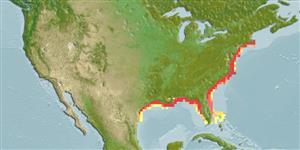Common names from other countries
>
Atheriniformes (Silversides) >
Atherinopsidae (Neotropical silversides) > Menidiinae
Etymology: Menidia: Greek, menoeides, -es, -es = like a half noon shape (Ref. 45335); beryllina: beryllina meaning emerald color (Ref. 10294).
More on author: Cope.
Environment: milieu / climate zone / depth range / distribution range
Écologie
marin; eau douce; saumâtre; profondeur 0 - 30 m (Ref. 108940). Subtropical; 42°N - 25°N, 98°W - 70°W
Western Atlantic: Massachusetts to southern Florida in USA and around Gulf of Mexico to northeastern Mexico.
Taille / Poids / Âge
Maturity: Lm ? range ? - ? cm
Max length : 15.0 cm TL mâle / non sexé; (Ref. 5723); common length : 7.8 cm TL mâle / non sexé; (Ref. 12193); âge max. reporté: 2.00 années (Ref. 72478)
Rayons mous anaux: 16 - 19; Vertèbres: 38 - 42
A brackish/marine species that ascends rivers (Ref. 86798). In fresh water, usually occurs at the surface of clear, quiet water over sand or gravel. Some landlocked populations, many of which have been established in impoundments as forage for sport fishes, reproduce in fresh water (Ref. 5723). Feeds on zooplankton (Ref. 10294), invertebrates, fish eggs and larvae and diatoms (Ref. 93252).
Life cycle and mating behavior
Maturité | Reproduction | Frai | Œufs | Fécondité | Larves
Robins, C.R. and G.C. Ray, 1986. A field guide to Atlantic coast fishes of North America. Houghton Mifflin Company, Boston, U.S.A. 354 p. (Ref. 7251)
Statut dans la liste rouge de l'IUCN (Ref. 130435)
CITES (Ref. 128078)
Not Evaluated
Menace pour l'homme
Harmless
Utilisations par l'homme
Plus d'informations
CollaborateursImagesStamps, Coins Misc.SonsCiguateraVitesseType de nageSurface branchialeOtolithesCerveauxVision
Outils
Articles particuliers
Télécharger en XML
Sources Internet
Estimates based on models
Preferred temperature (Ref.
115969): 12.7 - 26.1, mean 23.7 (based on 181 cells).
Phylogenetic diversity index (Ref.
82804): PD
50 = 0.5039 [Uniqueness, from 0.5 = low to 2.0 = high].
Bayesian length-weight: a=0.00513 (0.00229 - 0.01150), b=3.08 (2.89 - 3.27), in cm Total Length, based on LWR estimates for this (Sub)family-body shape (Ref.
93245).
Niveau trophique (Ref.
69278): 3.2 ±0.3 se; based on size and trophs of closest relatives
Résilience (Ref.
120179): Haut, temps minimum de doublement de population inférieur à 15 mois (tmax=1).
Fishing Vulnerability (Ref.
59153): Low vulnerability (10 of 100).
